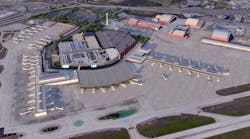I admit that upon reading a brief “MarketWatch” news story last week about the state of the airline industry’s finances, I immediately figured we could heap all the blame on the guy I typically sit next to on the plane. You know the guy I’m talking about: The one who thinks nothing of chowing down on an Italian beef in the middle seat.
“What we want is a leaner industry that no longer carries every person at any cost,” John P. Heimlich, vice president and chief economist for the Air Transport Association, told reporters last Wednesday at a mid-year economic review conference in Washington, D.C. Business travelers, he added, would be a bigger part of the passenger mix for many airlines.
I contacted the trade group, however, and now that I scrolled through Heimlich’s PowerPoint, I can see better where his hopes are for the industry and give the guy bringing his lunch along for the ride a break.
Heimlich effectively divided up his press briefing into three parts:
Where Have We Been: U.S. passenger airlines lost more than $65 billion from 2001 through 2009 before enjoying an extremely modest $2.2 billion profit last year. On the other hand, the airlines are back to losing $290 million so far in the first six months of this year. Higher costs aren’t limited to fuel either – although that’s up 170 percent between 2000 and 2010. In that same time frame, airport landing fees are up 70 percent; labor up 35 percent and professional services up 19 percent. Ticket prices alone can’t keep up with these costs. In a time when the Consumer Price Index increased 27 percent in the last decade, the revenue collected from an average domestic round-trip ticket went up by a relative bargain of only 7 percent.
Where Are We Now: The math is elementary: First-half 2011 results for 13 reporting carriers show that higher costs outpaced higher revenue. Only three airlines – Allegiant Air; Alaska Airlines and Spirit Airlines reported net margins of 5 percent or better. Starbucks stock, battered as it’s been in recent years, still has a bigger market capitalization than the combined market cap for all the country’s publicly traded airline stocks. And only one airline stock has an S&P investment-grade credit rating.
Where Are We Going: Heimlich didn’t mean that airlines are purposefully ignoring the leisure traveler - high unemployment and the nation’s dour economy is the main reason, he said, for its decline. Meanwhile, airlines are making strides in improving such customer service standards as on-time arrivals, taxi-out times, and lost baggage.
Another item airlines are clearly doing considering these economic challenges is continuing to cut capacity – and, by default, the number of cheap seats on planes. Heimlich said U.S. passenger airline capacity will be down 0.5 percent year-over-year in this fourth quarter after barely budging 1 percent year-over-year in the third quarter.
An interesting metric I hadn’t thought of much before I joined the industry is Available Seat Miles. ASMs will be down 10 percent in this fourth quarter compared to the pre-recession fourth quarter of 2007.
The industry’s gain? A fine, balancing point between demand and capacity. So the business traveler makes up more of the passenger list since those lists are that much smaller.
“Demand appears sufficiently strong given the level of capacity that’s out there,” Heimlich told reporters. “It’s all about balance and I think the balance is reasonably good now.”



